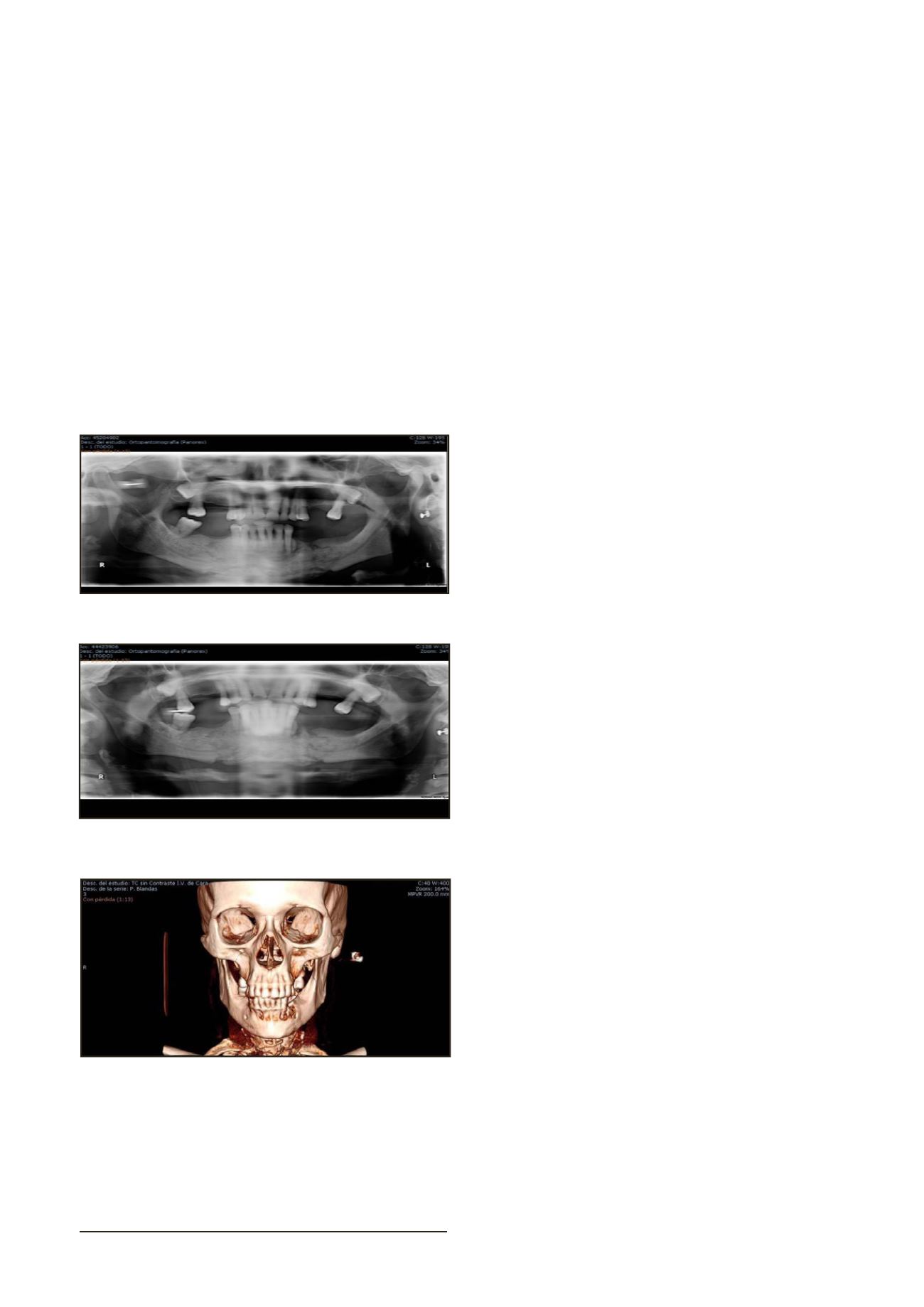

116
Paolo Cariati
Bilateral jaw fracture after long term treatment with bisphosphonates
intravenous antibiotic treatment was administered and a maxillo-
facial surgeon was contacted. A careful anamnesis revealed that
patient received long term therapy with bisphosphonates. In fact,
she was diagnosed with breast cancer eight years ago. Intraoral
examination showed bone exposure with active suppuration of
purulent matter in the third and fourth quadrants of the jaw. The
rest of the physical examination was normal. Bearing in mind the
patient’s history, we decided to perform an orthopantomography.
This test showed a major area of bone degeneration and a bilate-
ral non-displaced fracture of the mandible. Considering all this, the
patient was hospitalized in order to maintain intravenous antibio-
tic treatment. Treatment response was positive since the earliest
days. In view of that, we continue with this conservative approach
during ten days. We also perform a rigid blockage of the jaw and
a complete debridement of necrotic tissue. The clinic substantially
improve during the hospital stay. Finally, she was discharged from
hospital after two weeks with oral antibiotic for other four wee-
ks. Importantly, jaw blockage was also maintained during 4 weeks.
Patient was reviewed every 3-4 weeks for one year. It is important
to underline that during the follow-up, we observed that patient
remained asymptomatic.
DISCUSSION:
In recent times, the use of bisphosphonates is growing rapidly.
In fact, oral and intravenous preparations of this drugs are daily
prescribed for treating pathologies such as osteoporosis, rheumatic
pathologies and several metabolic bone diseases. In this light, the
main aim of the present report is to show the serious consequen-
ces that bisphosphonates could provoke on the jaw bone. In our
opinion, these complications are often underestimated by a vast
number of clinicians. This report raises three central points. First,
conservative treatment is preferable where possible in cases of
ONJ. In this line, unnecessary manipulation of the oral cavity should
be avoided in these patient. Second, an accurate oral examination
is mandatory before the beginning of bisphosphonate treatment.
In fact, the existence of dental pathology need to be diagnosed and
treated prior to commencement with antiresorptive medication.
This attitude might reduce the frequency of ONJ (10). Third, is the
consideration that bisphosphonates should be used with caution.
In fact, patients who receive bisphosphonates need a close moni-
toring for life. In addition, there are no effective treatments for this
disease.
BIBLIOGRAPHIC REFERENCES
1.
R.F. Barghash, W.M Abdou. Pathophysiology of Metastatic
Bone Disease and the Role of the Second Generation of
Bisph
osphonates:FromBasic Science to Medicine. Curr Pharm
Des. 2016.
2.
S.L. Ruggiero, T.B. Dodson, L.A. Assael, R. Landesberg, R.E. Marx,
B. Mehrotra; American Association of Oral and Maxillofacial
Surgeons. American Association of Oral and Maxillofacial
Surgeons position paper on bisphosphonate-related
osteonecrosis of the jaws. Oral Maxillofac Surg. 2009; 67: 2-12.
doi: 10.1016/j.joms.2009.01.009.
3.
M.J. Rogers, S. Gordon, H.L. Benford, F.P. Coxon, S.P. Luckman,
J. Monkkonen, J.C. Frith. Cellular and molecular mechanisms of
action of bisphosphonates. Cancer. 2000; 15: 2961-78.
4.
Advisory Task Force on Bisphosphonate-Related Ostenonecrosis
of the Jaws, American Association of Oral and Maxillofacial
Surgeons. American Association of Oral and Maxillofacial
Surgeons position paper on bisphosphonate-related
osteonecrosis of the jaws. J Oral Maxillofac Surg. 2007; 65:369-
76.
5.
F.L Heggendorn, T.C. Leite, K.S. Cunha, A.S. Junior, L.S. Gonçalves,
K.B. Da Costa, E.P. Dias. Bisphosphonate-related osteonecrosis
of the jaws: Report of a case using conservative protocol. Spec
Care Dentist. 2016; 36:43-7. doi: 10.1111/scd.12143.
6.
F.R. Pires, A. Miranda, E.S. Cardoso, A.S. Cardoso, E.R. Fregnani,
C.M. Pereira, M.E. Correa, J.P. lmeida , F. de A Alves , M.A. Lopes,
O.P. De Almeida. Oral avascular bone necrosis associated with
chemotherapy and biphosphonate therapy. Oral Dis. 2005;
11:365-9.
7.
C. Walter, M.O. Klein, A. Pabst, B. Al-Nawas, H. Duschner, T.
Ziebart. Influence of bisphosphonates on endothelial cells,
fibroblasts, and osteogenic cells. Clin Oral Investig. 2010; 14:35-
41. doi: 10.1007/s00784-009-0266-4.
8.
A.A. Polymeri, G.J. Kodovazenitis, A.D. Polymeris, M. Komboli.
Bisphosphonates: Clinical Applications and Adverse Events
in Dentistry. Oral Health Prev Dent. 2015; 13:289-99. doi:
10.3290/j.ohpd.a34370.
9.
S. Reiss, D. Sultan. Risk Factors in the Development of Oral
Bisphosphonate-induced Osteonecrosis. N Y State Dent J. 2015
Nov; 81:30-3.
10. R.H. Goodday. Preventive Strategies for Patients at Risk of
Medication-related Osteonecrosis of the Jaw. Oral Maxillofac
Surg Clin North Am. 2015; 27: 527-36. doi: 10.1016/j.
coms.2015.06.006.
Fig 1. Bilateral jaw fracture.
Fig 2. Jaw fracture evolution during patient follow-up
(one months after diagnosis)
Fig 3. Jaw fracture evolution during patient follow-up (nine months
after fracture reduction)

















